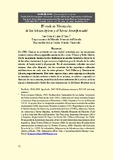| dc.rights.license | http://creativecommons.org/licenses/by-nc-sa/3.0/ve/ | es_VE |
| dc.contributor.author | López D’ Jesús, José Manuel | |
| dc.date.accessioned | 2020-08-06T03:56:39Z | |
| dc.date.available | 2020-08-06T03:56:39Z | |
| dc.date.issued | 2020 | |
| dc.identifier.issn | 1856-9927 | |
| dc.identifier.uri | http://www.saber.ula.ve/handle/123456789/46938 | |
| dc.description.abstract | En 1980, Caracas se convierte en una ciudad articulada por un imaginario
musical contracultural, específicamente en dos zonas: Chacao y Bello Monte.
Dicho imaginario emerge de dos tendencias musicales heredadas del rock: la
de los años cincuenta y la que ocurre en Inglaterra para la década de los años
setenta: el heavy metal y el pospunk. En el inconsciente colectivo nacional
suenan –diez años después– los dos nombres de los arquetipos culturales
emblemáticos en cada uno de estos géneros: Paul Gillman y Sentimiento
Muerto, respectivamente. Este texto expone cómo estos arquetipos culturales
se insertan en dichos sectores a través de su música, su estética corporal y el
discurso de sus canciones, transformándose en referentes de la cultura rock en
el país y funcionando desde dos caracterizaciones: la del héroe libertino en el caso de Paul Gillman y la del héroe épico en el caso de Sentimiento Muerto. | es_VE |
| dc.language.iso | es | es_VE |
| dc.publisher | SaberULA | es_VE |
| dc.rights | info:eu-repo/semantics/openAccess | es_VE |
| dc.subject | Rock | es_VE |
| dc.subject | Sentimiento muerto | es_VE |
| dc.subject | Paul Gillman | es_VE |
| dc.subject | Arquetipo | es_VE |
| dc.subject | Venezuela | es_VE |
| dc.subject | Historia | es_VE |
| dc.title | El rock en Venezuela: de los héroes épicos y el héroe desenfrenado | es_VE |
| dc.title.alternative | Rock in Venezuela: of epic heroes and the unbridled hero | es_VE |
| dc.type | info:eu-repo/semantics/article | es_VE |
| dc.description.abstract1 | In 1980, Caracas became a city articulated by a countercultural musical imagery,
specifically in two areas: Chacao and Bello Monte. This imaginary emerges from
two musical trends inherited from rock: that of the 1950s and the one that
occurred in England in the 1970s: heavy metal and post-punk. Ten years later,
the two names of the emblematic cultural archetypes in each of these genres
sound in the national collective unconscious: Paul Gillman and Sentimiento
Muerto, respectively. This text exposes how these cultural archetypes are
inserted in these sectors through their music, their body aesthetics and the
discourse of their songs, transforming themselves into references of rock culture
in the country and operating from two characterizations: that of the libertine
hero in the Paul Gillman and the epic hero in the case of Dead Sentiment. | es_VE |
| dc.description.colacion | 52-73 | es_VE |
| dc.description.email | Josemanuellopez888@gmail.com | es_VE |
| dc.description.frecuencia | Anual | |
| dc.publisher.pais | Venezuela | es_VE |
| dc.subject.centroinvestigacion | Centro de Investigaciones en Ciencias Humanas (HUMANIC) | |
| dc.subject.centroinvestigacion | Grupo de Investigaciones sobre Historia de las Ideas en América Latina (GRHIAL) | |
| dc.subject.facultad | Facultad de Humanidades y Educación | es_VE |
| dc.subject.institucion | Universidad de Los Andes | es_VE |
| dc.subject.keywords | Rock | es_VE |
| dc.subject.keywords | Sentimiento Muerto | es_VE |
| dc.subject.keywords | Paul Gillman | es_VE |
| dc.subject.keywords | Archetype | es_VE |
| dc.subject.keywords | Venezuela | es_VE |
| dc.subject.keywords | History | es_VE |
| dc.subject.seccion | Anuario GRHIAL: Artículos científicos (Monográficos) | es_VE |
| dc.subject.tipo | Revistas | es_VE |
| dc.type.media | Texto | es_VE |


